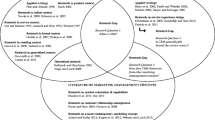Abstract
This paper examines the effectiveness of business-to-business relationships in reference to the suppliers of office equipments serving the industrial accounts in Mexico. The study addresses broadly the performance-related issues as to what extent is the impact of quality of services responsible for doing business with the organizational buyers. Discussions in the paper also analyse the impact of channel function performance on relationship quality, which is moderated by the extent dependence structure of the relationship. The results of the study showed that the impact of buyer–supplier co-dependency and relationship quality significantly affects the supplier performance. It has been argued in the paper that the market orientation is positively associated with measures of channel performance such as service quality and the extent of buyer satisfaction. The study also demonstrates that in the processes of managing business relationships, cognitive dimensions like trust, commitment, and low level of conflicts provide ‘win-win’ situation for buyers and suppliers. Finally, this study attempts to make contributions to the literature on buyer–supplier relationships towards cognitive and relational perspectives leading to optimizing functional efficiency of a firm.
Similar content being viewed by others
References
Anderson JC and Narus JA (1990). A model of distributor firm and manufacturer firm working partnerships. J Market 54(1): 42–58.
Bac M (2000). Switching costs and screening efficiency of incomplete contracts. Canad J Econ 33(4): 1034–1048.
Black SA and Porter LJ (1996). Identification of the critical factors of TQM. Decis Sci 27(1): 1–27.
Butler JK (1991). Towards understanding and measuring conditions of trust—Evolution of trust inventory. J Mngt 17: 643–663.
Buzzel RD and Weirsema FD (1981). Modelling changes in market share: A cross sectional analysis. Strat Mngt J 2(1): 27–42.
Chang TZ, Mehta R, Chen SJ, Polsa P and Mazur J (1999). The effects of market orientation on effectiveness and efficiency: The case of automotive distribution channels in Finland and Poland. J Serv Market 13(4–5): 407–418.
Dicken P (1998). Global Shift—Transforming The World Economy. Paul Chapman: London.
Doornik K (2006). Relational contracting in partnerships. J Econ Mngt Strat 15(2): 517–548.
Dwyer FR, Schurr PH and Oh S (1987). Developing buyer–seller relationships. J Market 51(April): 11–27.
Emerson RM (1962). Power-dependence relation. Am Sociol Rev 27(February): 31–41.
Flynn BB, Schroeder RG and Sakaibara S (1994). A framework for quality management research and an associated measurement instrument. J Opns Mngt 11(4): 339–366.
Forker LB (1997). Factors affecting supplier quality performance. J Opns Mngt 15(4): 243–269.
Frazier GL and Rody RC (1991). The use of influence strategies in inter-firm relationships in industrial product channels. J Market 55(January): 52–69.
Ganeshan S (1994). Determinants of long term orientation in buyer–seller relationships. J Market 58(April): 1–19.
Garbarino E and Johnson MS (1999). The different roles of satisfaction, trust and commitment in customer relationships. J Market 63(April): 70–87.
Geyskens I, Steenkamp J-BEM and Kumar N (1998). Generalizations about trust in marketing channel relationships using meta-analysis. Int J Res Market 15: 223–248.
Halldórsson Á and Skjøtt-Larsen T (2006). Dynamics of relationship governance in TPL arrangements—a dyadic perspective. Int J Phys Distrib Logist Mngt 36(7): 490–506.
Harwood TG (2006). Developing buyer–seller relationships through face-to-face negotiations. J Relation Market 4(3–4): 105–122.
Hibbard JD, Kumar N and Stern LW (2001). Examining the impact of destructive acts in marketing channel relationships. J Market Res 38: 45–61.
Hill C (1990). Cooperation, opportunism, and the invisible hand: Implications for transaction cost theory. Acad Mngt J 15(3): 500–514.
Ittner CD and Larcker DF (1996). Financial impact of quality initiatives. Adv Mngt Org Qual 1: 1–37.
Jaccard J, Turrisi R and Wan CK (1990). International Effects in Multiple Regression. Sage University Press: Thousand Oaks, CA.
Kumar N and Scheer LK (1995). The effects of perceived interdependence on dealer attitudes. J Market Res 32: 348–356.
Morgan RM and Hunt SD (1994). The commitment–Trust theory of relationship Marketing. J Market 58(July): 20–38.
Noordewier TG, John G and Nevin JR (1990). Performance outcomes of purchasing arrangements in industrial buyer–vendor relationships. J Market 54(October): 80–93.
Peck H (2006). Reconciling supply chain vulnerability, risk and supply chain management. Int J Logist 9(2): 127–142.
Rajagopal (2005). Measuring variability factors in consumer values for profit optimization in a firm—A framework for analysis. J Econ Mngt 1(1): 85–103.
Robicheaux RA and Coleman JE (1994). The structure of marketing channel relationships. J Acad Market Sci 22(1): 38–51.
Rogers PA (2006). Optimizing supplier management and why co-dependency equals mutual success. J Facilities Mngt 4(1): 40–50.
Sirohi N, McLaughlin EW and Wittink DR (1998). A model of consumer perceptions and store loyalty intentions for a supermarket retailer. J Retailing 74(2): 223–245.
Smith W, van Bruggen GH, Wierenga B (2002). Building stronger channel relationship though information sharing. Discussion Paper, 235, Erasmus Research Institute of Management, pp 1–62.
Squire B, Cousins PD and Brown S (2005). Collaborating for customization: An extended resource-based view of the firm. Int J Prod Qual Mngt 1(1–2): 8–25.
Swink M and Zsidisin G (2006). On the benefits and risks of focused commitment to suppliers. Int J Prod Res 44(20): 4223–4240.
Trkman P, Štemberger MI, Jaklic J and Groznik A (2007). Process approach to supply chain integration. Supply Chain Mngt: An Int J 12(2): 116–128.
Ulaga W and Eggert A (2006). Relationship value and relationship quality: Broadening the nomological network of business-to-business relationships. Eur J Market 40(3–4): 311–327.
Voss MD, Calantone RJ and Keller SB (2005). Internal service quality: Determinants of distribution center performance. Int J Phys Distrib Logist Mngt 35(3): 161–176.
Wathne KH and Heide JB (2000). Opportunism in inter-firm relationships: Forms, outcomes and solutions. J Market 64(October): 36–51.
Wilson DT and Kristan MKE (1991). Buyer–seller relationship: Alternative conceptualization. In: Poliwoda S.J. (ed). New Perspectives on International Marketing. Routledge: London, pp. 87–107.
Acknowledgements
The authors sincerely thank the anonymous referees for offering their valuable comments to improve the quality of this paper.
Author information
Authors and Affiliations
Corresponding author
Rights and permissions
About this article
Cite this article
Rajagopal, Rajagopal, A. Buyer–supplier relationship and operational dynamics. J Oper Res Soc 60, 313–320 (2009). https://doi.org/10.1057/palgrave.jors.2602560
Received:
Accepted:
Published:
Issue Date:
DOI: https://doi.org/10.1057/palgrave.jors.2602560




